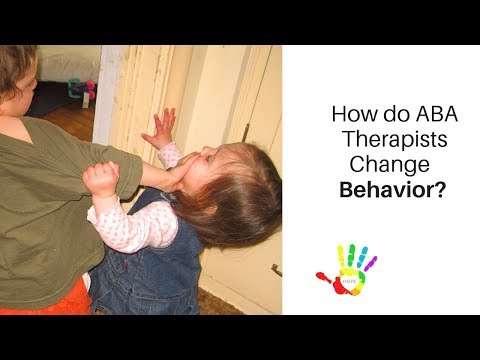In the first video in this series, I explained what ABA is. In this video I will explain how ABA therapist change a behavior. Disclaimer: Credits:
A new video will be posted to this series weekly. Subscribe so you do not miss a video and send video requests or questions to Jessica@JessicaLeichtweisz.com
Credits:
Photo: Morguefile
Sound effect: Incomputek
Intro: Graeme Kan
Video Production: Nathan Bedford
Disclaimer:
This video is intended for information purposes only. It is not intended to diagnose or treat any medical condition. The text, graphics, images, flash movies, and audio segments are not intended to be a substitute for professional medical advice, diagnosis, or treatment. Always seek the advice of your physician or other qualified health provider with any questions you may have regarding a medical condition.
The information contained in this segment is generalized. It may not be applicable in every situation. Before applying specific interventions, consult a behaviorist. Any behavior intervention can result in an undesired change in behavior if not implemented correctly. No client relationship is established as a result of watching these videos. Jessica Leichtweisz and Hope Education cannot be held responsible for any misuse of the information contained in these videos. <br> <h3>Auto Generated Captions</h3>
[Music]
hey guys and welcome to episode 3 of our
series on ABA so if you haven’t watched
the first two episodes I recommend you
check them out it’s good to watch this
particular series in order and I’ll tell
you a little bit about why I’m doing
this if you’ve missed it so I’ve been
doing ABA for nine years and I’m really
really passionate about helping families
work with her therapists I really get
the best outcome for their children and
so I decided to create information that
easy for parents to understand and
accessible so last week we learned that
an ABA therapists tries to change a
behavior either to increase it or
decrease it and so tonight we’re going
to talk a little bit about how they go
about that so there’s three big letters
in ABA and actually they’re not ABA
there are a b c so that stands for the
antecedent the behavior and the
consequence an antecedent is what
happens before behavior occurs the
behavior that’s pretty obvious it’s the
behavior and the consequence is what
happens after the behavior occurs so
there’s two really main ways that an ABA
therapists changes the behavior the
first is the most important and that’s
the antecedent modifications those are
the proactive measures that an ABA
therapist will take to make sure a child
successful now that can look like many
things visual cues a sensory diet breaks
schedules schedules frequent access to
toys that they like it could be
rearranging a room or maybe taking them
to a park before the session occurs to
get some of their energy out all those
things are things you’re gonna do to
either make a behavior more or less
likely to occur before it happens now
the reason this is the most important
part is because oftentimes what a
therapist is working on our behaviors
that we really don’t want to say
and the best way to teach that is to
avoid them because anytime a behavior
happens that we don’t want to occur
let’s say a tantrum
it’s in some degree reinforcing it so we
want to make sure we do everything we
can to prevent a behavior when we’re of
course decreasing behaviors so it
doesn’t occur but what if it does occur
well that’s the second part and those
are the consequence manipulations now
there are two types of consequence
manipulations number one is what we’re
gonna do if we want a behavior to occur
more often and that’s reinforcement and
that can be anything such as giving a
child a break taking them outside to
play giving them a snack or their
favorite toy or even just saying great
job so the second part of it is what
we’re gonna do if we don’t want a
behavior to occur and there there’s two
types of really common consequence
manipulations that are used to decrease
behaviors the first is extinction and
the second is a punishment procedure
extinction essentially means don’t let
the behavior work and what that looks
like exactly will really be determined
by the function of the behavior that’s
the most likely one you are to see an
ABA therapists using according to the
the BAC B the board of certified
behavior therapists you can’t use a
punishment procedure until you’ve tried
reinforcement procedures it’s very rare
that you actually use a punishment
procedure in an official ABA case in my
nine years of doing ABA I think I’ve
encountered ever times on my hand that
I’ve actually used punishment so it’s
not likely that you’re going to wind up
seeing that but punishment is obviously
a way that you can decrease a behavior
so I hope that helps and really figuring
out how we’re going to be addressing the
behavior change in an ABA session if you
have any specific questions that you
have please feel free to reach out I’m
really passionate about helping you and
getting your questions answered my
emails Jessica at Jessica likewise calm
shoot me an email and I’m happy to help
god bless make it a great night and stay
tuned for episode four
[Music]
you
How do ABA Therapists Change Behavior? Part 3: Free ABA Family Training Video! KU-AwBng8F4
[Music]
hey guys and welcome to episode 3 of our
series on ABA so if you haven’t watched
the first two episodes I recommend you
check them out it’s good to watch this
particular series in order and I’ll tell
you a little bit about why I’m doing
this if you’ve missed it so I’ve been
doing ABA for nine years and I’m really
really passionate about helping families
work with her therapists I really get
the best outcome for their children and
so I decided to create information that
easy for parents to understand and
accessible so last week we learned that
an ABA therapists tries to change a
behavior either to increase it or
decrease it and so tonight we’re going
to talk a little bit about how they go
about that so there’s three big letters
in ABA and actually they’re not ABA
there are a b c so that stands for the
antecedent the behavior and the
consequence an antecedent is what
happens before behavior occurs the
behavior that’s pretty obvious it’s the
behavior and the consequence is what
happens after the behavior occurs so
there’s two really main ways that an ABA
therapists changes the behavior the
first is the most important and that’s
the antecedent modifications those are
the proactive measures that an ABA
therapist will take to make sure a child
successful now that can look like many
things visual cues a sensory diet breaks
schedules schedules frequent access to
toys that they like it could be
rearranging a room or maybe taking them
to a park before the session occurs to
get some of their energy out all those
things are things you’re gonna do to
either make a behavior more or less
likely to occur before it happens now
the reason this is the most important
part is because oftentimes what a
therapist is working on our behaviors
that we really don’t want to say
and the best way to teach that is to
avoid them because anytime a behavior
happens that we don’t want to occur
let’s say a tantrum
it’s in some degree reinforcing it so we
want to make sure we do everything we
can to prevent a behavior when we’re of
course decreasing behaviors so it
doesn’t occur but what if it does occur
well that’s the second part and those
are the consequence manipulations now
there are two types of consequence
manipulations number one is what we’re
gonna do if we want a behavior to occur
more often and that’s reinforcement and
that can be anything such as giving a
child a break taking them outside to
play giving them a snack or their
favorite toy or even just saying great
job so the second part of it is what
we’re gonna do if we don’t want a
behavior to occur and there there’s two
types of really common consequence
manipulations that are used to decrease
behaviors the first is extinction and
the second is a punishment procedure
extinction essentially means don’t let
the behavior work and what that looks
like exactly will really be determined
by the function of the behavior that’s
the most likely one you are to see an
ABA therapists using according to the
the BAC B the board of certified
behavior therapists you can’t use a
punishment procedure until you’ve tried
reinforcement procedures it’s very rare
that you actually use a punishment
procedure in an official ABA case in my
nine years of doing ABA I think I’ve
encountered ever times on my hand that
I’ve actually used punishment so it’s
not likely that you’re going to wind up
seeing that but punishment is obviously
a way that you can decrease a behavior
so I hope that helps and really figuring
out how we’re going to be addressing the
behavior change in an ABA session if you
have any specific questions that you
have please feel free to reach out I’m
really passionate about helping you and
getting your questions answered my
emails Jessica at Jessica likewise calm
shoot me an email and I’m happy to help
god bless make it a great night and stay
tuned for episode four
[Music]
you
https://i.ytimg.com/vi/KU-AwBng8F4/hqdefault.jpg aba,applied behavior analysis,applied behaviour analysis,autism,special education,hope education services,early intervention,aba therapy,aba therapist,autism treatment,autism therapy,autism family,facts about autism,autism facts,autism video,videos about autism,how do you treat autism,what is autism like,what is autism for kids,autistic,autistic kid,autistic adult,autism teacher,autism help,autism traits,aba therapy session,spectrum disorder In the first video in this series, I explained what ABA is. In this video I will explain how ABA therapist change a behavior. Disclaimer: Credits:
A new video will be posted to this series weekly. Subscribe so you do not miss a video and send video requests or questions to Jessica@JessicaLeichtweisz.com
Credits:
Photo: Morguefile
Sound effect: Incomputek
Intro: Graeme Kan
Video Production: Nathan Bedford
Disclaimer:
This video is intended for information purposes only. It is not intended to diagnose or treat any medical condition. The text, graphics, images, flash movies, and audio segments are not intended to be a substitute for professional medical advice, diagnosis, or treatment. Always seek the advice of your physician or other qualified health provider with any questions you may have regarding a medical condition.
The information contained in this segment is generalized. It may not be applicable in every situation. Before applying specific interventions, consult a behaviorist. Any behavior intervention can result in an undesired change in behavior if not implemented correctly. No client relationship is established as a result of watching these videos. Jessica Leichtweisz and Hope Education cannot be held responsible for any misuse of the information contained in these videos.



